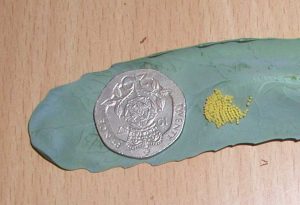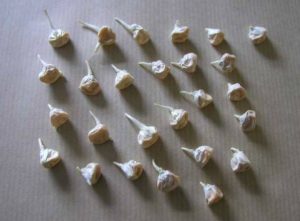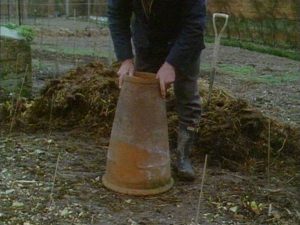Fruit & Vegetable Growing Guide for July
July looks like it’s going to be one of the hottest and driest months so a lot of time will have to be spent watering. Try to reduce water loss and so save yourself some time by mulching with a layer of organic matter. This will help preserve moisture but may encourage slugs so measures to control them will also be necessary.

An allotment in full production in July. The plot holder is in the shed making tea as it’s about to rain.
Another good method of preventing water loss is to hoe. As well as killing weeds this breaks up the surface of the soil and so prevents evaporation of water drawn there by capillary action.
Sowing & Planting
Although the sowing season is coming to a close there are still things to sow in July.
If you have early potatoes they should come out of the ground now so that it can be used for other crops.
Most seeds can now be sown directly. In dry weather draw a drill and water it well prior to sowing and then just water with a fine rose after to settle the seeds in.
In really hot spells you might need to water young seedlings early morning and late evening to establish them.
- Spring Cabbage
- Chicory
- Chinese cabbage
- Kohl rabi
- Lettuce
- Peas
- French Beans
- Beetroot
- Carrots
- Radishes
- Turnips
Planting Out
If they’ve not gone in yet, it’s time to plant out leeks. Just dib a hole about 150mm deep and drop a seedling into the hole. Water it in and the job’s done. Don’t follow old advice about trimming the tops and roots, it has no beneficial effect and is probably harmful. You don’t need to fill the holes with soil, enough will wash in with watering and rain. The reason you plant in a hole is to blanch the stem.
Brassicas from pots can go out as well: broccoli, calabrese, Brussel sprouts and cabbage
Green Manures
Many follow on first early potatoes with leeks but otherwise a green manure can be sown on bare ground which will otherwise just grow weeds. Mustard is fast growing and is supposed to confuse the potato eel worm into breeding at the wrong time, hence it’s a suitable follow on to potatoes. It is a brassica so don’t use it if you suffer from club root.
Another fast growing green manure are French beans. Even if you have enough beans for the kitchen, the plant produces a fair amount of leaf and stem plus the roots, as with all legumes, have nodules containing bacteria that fix nitrogen from the atmosphere. .
Cultivation, Pests & Problems
If you have not netted brassicas against butterflies (and probably if you have!) then check them for butterfly eggs.
It really is worth double checking, look close to the stem, and and well as eggs destroy any caterpillars that may have hatched out. There’s little left in the gardener’s kit bag in the way of sprays nowadays so pick them off into a bucket and drown them.
A major cause of poor crops with potatoes is poor nutrition. They are a very greedy plant and a boost now will pay a dividend in tubers. A balanced tomato feed is ideal.
Keep on top of the weeds, it really is far easier to hoe them as small seedlings than as grown plants. Even if you can not see any weeds, hoeing will actually be killing tiny seedlings you have not noticed and will help to reduce moisture loss
Pinch out the tops of broad beans which are the part of the plant most attractive to blackfly. Another ‘trick’ is to plant nasturtiums nearby. These attract blackfly and you can then pull out the nasturtiums and the blackfly with them.
Keep onions well weeded and don’t forget to feed them to get a better crop. As they mature they need to dry out so don’t over water, if at all. Keeping weeds down allows air to circulate and inhibits the growth of moulds.
Fruit
In a prolonged dry spell like we have been ‘enjoying’ don’t forget that that fruit bushes and trees need watering. Swelling apples and currants need water as much as leafy vegetables. Give them a good soaking rather than little sprinkles that encourage surface rooting.
Finish thinning apples, pears and plums if needed. It’s the right time for summer pruning as well. Keep the base of trees weed and grass free, mulch to keep in moisture and add fertility with garden compost.
Pick soft fruits. Don’t forget to use strawberry runners to grow new plants and remove unwanted runners so the plants retain strength. Grub up and replace in another spot strawberries after 3 or 4 years cropping.
Fruit & Vegetable Growing Guide for June
June is the last month for sowing many crops as we pass the longest day on 21st and head downhill thereafter. Planting out from successional sowings in modules and pots will maximise the use of space but you may be wondering where to fit things in by now.
Don’t be too precious about rotational plans, plans are great until they bump head with reality
Sowing & Planting on the Vegetable Plot
Direct Sowing
In dry weather draw drills and water well prior to sowing and then just water with a fine rose to settle the seeds.
Successional sowing each fortnight of beetroot, French beans, early carrots, kohlrabi, early peas, lettuce, rocket, turnips, endive, radish, spring onions will give you a constant supply of salads and vegetables.
All the following can also be sown:
- French and Runner Beans
- Maincrop peas
- Beetroot
- Carrots
- Turnips
- Swedes
- Cauliflowers
- Chicory
- Sweetcorn
- Squash
- Courgette and Marrows
Planting Out
If you have started them in pots or trays it’s now time to plant out:
- Broccoli
- Calabrese
- Brussels sprouts
- Summer cabbage
Pot grown runner and dwarf beans should also be safe to plant out now as the danger of frost has passed. Outdoor tomatoes can also go into their final position. Don’t just move them straight from the greenhouse or their growth will be checked. Use a cold frame to condition them for a few days before putting them out.
Leeks can be planted out as a follow on to early potatoes which should be ready for lifting by the end of the month. When transplanting leeks don’t follow the old method of chopping the top foliage and roots back, it doesn’t do any good.
Cultivation, Pests & Problems
If the weather stays dry and bright you will be busy watering. But don’t just lightly sprinkle the ground. This just helps pests like slugs and encourages shallow rooting. Water when the soil is dry to a depth of a few inches below the surface (stick your finger in to see). And then do it thoroughly – about 10 litres per square metre. This should then last at least a week of hot, dry weather.
Watch out for slugs & snails. Whether you use organic pellets, traps, biological controls or just pick them off doesn’t matter as long as you keep on top of the problem
Butterflies are about now as well. Beautiful as they are, check the undersides of brassica leaves for the yellow or white eggs that will hatch into caterpillars and devastate the plant. You can squash them, wipe or wash them off easily at this stage.
Caterpillar Eggs
Clusters of 2mm yellow or white spheres. Check for them frequently and crush them when found.
Fruit
If we do get a prolonged dry spell, don’t forget that that fruit bushes and trees need watering too. Swelling apples and currants need water as much as leafy vegetables. Once again, give a good soaking rather than little sprinkles that encourage surface rooting.
In June apples have “June Drop” where the tree drops excess fruit. After this it is worth thinning out even more if the branches are still overcrowded. Tie in blackberry canes as they grow and check that netting and fruit cages have no access for the birds.
When you’ve had the last stick of rhubarb, give the plant a good feed by mulching with well-rotted manure mixed with compost or an artificial fertiliser like Growmore to enable it to build strength for next year.
Fruit & Vegetable Growing Guide for May
May is one of the busiest months on the vegetable plot. The soil is warm and the plants growing well. But watch out for a sneaky late frost. Keep an eye on the weather forecast and be prepared to protect tender plants by wrapping them with insulation.
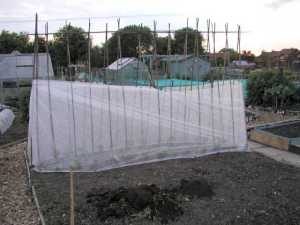
Beans wrapped in bubble wrap to protect from a frost.
If you do not have any horticultural fleece you can use old net curtains, bubble wrap and the traditional newspaper as a method of insulation when a cold night is forecast.
Sowing & Planting on the Vegetable Plot
Cultivation
There are two main cultivation jobs to keep on top of in May.
First, the weeds are now growing fast! Hoe them off as small seedlings. This will make the job far easier than waiting for them to send their roots down. Hoeing is best done on a dry day so that the weeds do not have a chance to recover. Don’t forget to sharpen your hoe before you start and resharpen frequently as you go.
Second is thinning out. Many people hate to remove the seedlings they were so happy to see appear, but it needs to be done because each one needs space to develop and if you don’t thin out all your plants will be weak and undersize.
Sowing outdoors
There is a lot to sow this month and with many crops you can sow one set and then a few weeks later re-sow to give you a succession of fresh vegetables at the peak of perfection. If it is a dry May, it is a good idea to soak seed drills before sowing and then just water with a fine rose after sowing and covering with a fine layer of soil.
- French Beans
- Runner Beans
- Beetroot
- Broccoli and Calabrese
- Cabbage and Cauliflowers
- Chicory
- Kale
- Kohl rabi
- Peas
- Turnips and Swedes
- Your salad crops should be sown in succession
- Lettuce and Leaves such as Rocket
- Radishes
- Spring Onions
Sowing under cover
These really don’t like starting in the cold and you only need relatively few plants so starting off in pots is well worth the investment.
- Sweetcorn
- Courgette
- Marrow
- Pumpkin
- Squash
Sweetcorn does not like its roots being disturbed so try sowing them in cardboard toilet roll inners packed with compost. They can then be planted out in the roll when ready.
Planting Out
If your plants are large enough, you can plant out now:
- Brussels sprouts
- Summer cabbages
- Celery
- Celeriac
- Leeks.
With leeks a good rule of thumb is to get the seedling about as thick as a pencil. Dib a hole about six inches deep using something like an old spade handle and drop the seedling in. Water well and allow the soil to fall back in naturally.
The old method of trimming the roots and top before transplanting leeks is not actually a good thing and has been shown to be detrimental. It’s a big enough shock to the plant being taken out of its seedbed.
Fruit
It’s mainly a matter of ensuring that you, rather than the birds, get the crops . A fruit cage is a big investment but very effective, otherwise use netting to keep the birds away.
Strawberries planted this year will perform better in subsequent years if you remove the flowers so they don’t set fruit in the first year but concentrate instead on building their strength for next.
General Tasks
Perennial weeds like dandelion and dock cannot be destroyed by hoeing and their roots have to be removed to prevent re-growth. Bindweed can be a nightmare to eradicate because any small piece of root will grow. It is easier by far to use glyphosate based weedkiller, which will go to the roots and kill the plant. However, there are now some question marks over the safety of glyphosate
On the subject of weedkillers, if you have used a product such as ‘Weed and Feed’ on your lawn, the mowings may be toxic to your crops. Check the manufacturer’s instructions carefully prior to composting
Harvest
Depending where you are and what you planted, you may have some salad crops ready. Hardylettuce and spring onions, fast growing radish and asparagous may also be available.
Fruit & Vegetable Growing Guide for April
Sowing & Planting on the Vegetable Plot
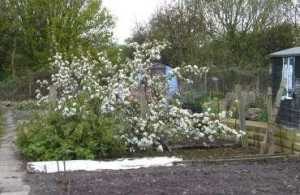
Apple Blossom in April on fan-trained trees
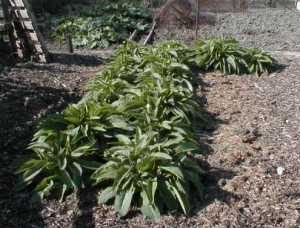
Comfrey nearly ready for cutting – the most useful herb you can grow.
March has been difficult and it’s going to be a busy April. Onions should be in by now so if they’re not yet planted make it one of the first jobs of the month.
Weeds are growing strongly and it’s time to sharpen your hoe. A sharp hoe is the best friend a gardener can have. Just slide it back and forth slightly below the surface of the soil and stop weed seedlings from taking hold.
There’s an old saying “Hoe when you can’t see a weed and you’ll never see a weed”. Hoeing keeps the top soil broken up so in times of drought moisture in the soil does not evaporate by being drawn to the surface by capillary action. When it does rain a hoed surface will also prevent the water running off and ensure it gets down to where it’s needed.
Things to Sow in April
- Beetroot
- Peas
- Broad Beans
- Broccoli
- Brussels Sprouts
- Cabbage
- Cauliflower
- Kale
- Chard
- Kohl Rabi
- Leeks
- Spinach
- Rocket
- Lettuce
- Radish
Cover carrots with a fleece ensuring the edges are buried. This will stop carrot root fly from laying eggs by your carrots. The eggs hatch into larvae that burrow into carrot roots, killing or at least ruining the crop.
Plant Outdoors
- Onion & Shallot Sets
- Globe Artichokes
- Jerusalem Artichokes
- Asparagus.
Early April is the traditional time for planting potatoes. If you have a comfrey bed and it has sprung back, the first cut laid in the trench under the potatoes will provide nutrition to get them off to a good start. Many novice growers wonder why they have small crops of potatoes and most often this is just down to lack of food for this hungry crop.
Growing Sweetcorn
Try pre-chitting sweetcorn to give it a good start. Lay the seeds on a layer of damp kitchen paper in an airtight box and place another layer of paper on top. An old ice-cream carton or a Tupperware type box is ideal. Seal the box and check carefully each day. As soon as the small white sprout appears, plant the seed about half to an inch deep in a 3″ pot of general purpose compost in the greenhouse.
When the shoots are about an inch high, plant out under a cloche, being careful not to disturb the root (sweetcorn hates root disturbance). Sweetcorn needs a lot of nitrogen and a teaspoon of dried blood will help get it underway.
Fruit
Strawberries can be planted out now, it’s best to remove flowers in the first year to conserve strength for growth and to get larger crops in subsequent years. An easy way to increase strawberry plants is to plant the runners in pots and cut the runner when rooted. The plants don’t last forever so you need to replace them every three to five years.
A good layer of compost around the base of fruit trees will ensure they have the nutrition to provide another good crop for you.
Check stored crops
Do check the last of your stored crops. On a fine day, empty them out and check for any rotten potatoes. If you’ve got onions strings, watch out for any rotten ones and remove them.
Fruit & Vegetable Growing Guide for March
March brings the spring equinox and the start of the growing season. Until the mid 18th century Lady Day, The Feast of the Annunciation, on 25th March was also the beginning of the calendar year. It changed to 1st January when we adopted the Gregorian calendar in 1752.
Sowing & Planting in the Vegetable Plot

First cloche set up on the plot for onions
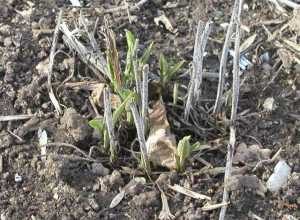
Comfrey coming back to life – the most useful herb you can grow.
e
If the weather is cold but otherwise reasonable, you can steal some time and start early by cloching and fleecing.
Although expensive glass cloches have been around for many years, nowadays you can get cheap polythene tunnel cloches and even cheaper horticultural fleece.
Put the cloche or fleece in place a week or two before planting to warm the soil and to leave it dry and easy to work.
Water well into the drill prior to sowing and replacing the cloche. Do remember to water weekly or more frequently in sunny weather.
To secure fleece without tearing, save plastic 2 litre milk containers and fill with sand or water, although water tends to leak. The smooth surface will weigh down the fleece but not damage it. It’s surprising how just a layer of fleece can raise the temperature of the underlying soil.
Plant out onion and shallot sets. You can also direct sow onions seeds, thinning to their eventual spacing. Cloching will help them to become established and also stop pigeons from pulling them up.
March is the right time to establish an asparagus bed if you are starting from crowns. Do make sure you get it in the right position as it will be there permanently.
Jerusalem artichoke tubers can be planted now. Be aware that getting them all up at harvest time is very difficult and any tubers left in the ground will grow again, so effectively you’re creating a permanent bed.
Things to Sow
- Beetroot
- Broad Beans
- Early Peas
- Brussels sprouts – early varieties like Peer Gynt will be ready in September
- Kohl Rabi
- Leeks
- Lettuce
- Radish
- Parsnips
- Spinach Beet
- Early Turnips
Fruit
Planting & Pruning
There is still time to finish planting bare rooted fruit trees and bushes, especially raspberries and other cane fruits.
Early this month you can still prune apple and pear trees while they are dormant. There is also time to prune gooseberries and currants. With currants shorten the sideshoots to just one bud and remove old stems from the centre of the bushes.
Fruit bushes will benefit from some compost spread around the base as well or some general purpose fertiliser like fish, blood & bone. Trees will appreciate some wood ash spread under them.
Harvest
Any leeks left standing should come up now – you can freeze them for use in soups and stews or make concentrated leek & potato soup to freeze and thin out when used. Parsnips too should come up in early March before they try to re-grow. They’ll store for a month or so in damp sand but no longer.
You may have also have spinach beet and chards, the last of the late Brussels sprouts, winter cauliflowers, kale, purple sprouting broccoli, swedes and scorzonera.
Fruit & Vegetable Growing Guide for February
February is the last of the winter months but it can also be the coldest month. So, take careful account of conditions: It’s better to hold off than to sow in waterlogged, near frozen ground that will most likely rot any seeds. And watch out for good weather in early February – it may not last.
Sowing & Planting Vegetables
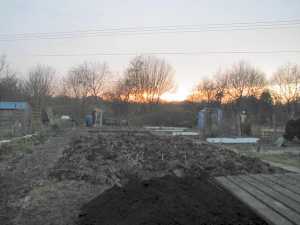
An allotment in February sunset
If the weather allows, you can direct sow broad beans in February along with early peas such as Feltham First and Meteor for a May / June harvest. If the weather is very cold though it would be better to start peas in a greenhouse or a coldframe and plant out later.
Traditionally, seed potatoes should be being chitted by now. Chitting is the process of sprouting tubers before planting. Some authorities say it benefits maincrops, but not earlies; some say it is of benefit to all types and others say it’s a waste of time and of no benefit at all. Given this uncertainty one option is to follow a version of Pascal’s wager: it does no harm and it might do some good so you may as well chit them.
To chit seed potatoes put them in a cool but frost free place where they get light but not direct sunlight. The potatoes will then grow short stubby shoots intended to get them off to a fast start when planted out.
Conventional advice is to sow parsnips now but some believe their reputation for poor germination rates is due to being sown in cold wet soil and that much better germination rates may be obtained by sowing in March or even April.
Jerusalem artichokes and shallots can be planted now, although shallots will benefit from covering with a cloche.
Under Cover in Coldframe and Polytunnel
it’s time to sow summer cabbages such as Greyhound and Primo, as well as turnips and spinach.
Onions from seed should also be started now. They need about 15 degrees C to get them going so it might be best using a windowsill in a cool room to start them off.
With a heated propagator or windowsills you can also start off aubergine and peppers, chillies and tomatoes.
As mentioned for January, the big problem at this time of year is the lack of available light. Covering cardboard with aluminium foil and standing it to the north side of the seed tray will reflect extra light and help prevent leggy, drawn seedlings without the expense of special horticultural lights.
Planting & Pruning Fruit
There is still time to finish planting fruit trees and bushes, especially raspberries and other cane fruits.
Early this month you can prune apple and pear trees while they are still dormant. It’s also time to prune gooseberries and currants. With currants shorten the sideshoots to just one bud and remove old stems from the centre of the bushes.
Forcing Rhubarb
Rhubarb can be forced for an early crop of the sweetest stalks. Just cover a crown or two with large buckets or even an upturned black bin and insulate the outside with straw or manure for added heat. The stalks will grow in the dark.
In years gone by there were specialist forcing pots for this task but a large one like the one in the picture with a lid could set you back £60.
The drawback of forcing is that this takes a lot out of the crown and it won’t recover for a couple of years.
The professional growers in the famous Rhubarb Triangle dig up their crowns and take them into huge dark warm sheds to produce forced rhubarb. Once the season ends these exhausted crowns are discarded as it will take them longer to recover than to grow new crowns.
General Jobs on the Plot
If you have finished all the major tasks, such as digging over, creating leafmould heaps etc you will not have a lot to do in February but if like most of us you are scrambling to keep up, this is your last chance before spring.
Check last year’s potato bed for any volunteers (left over small potatoes) and remove them to avoid passing on disease problems and blight. This years potato bed will benefit from a good application of compost or rotted manure that can be forked in or rotavated in to get them away.
You’re soon going to be using your pots and seed trays so this is a good opportunity to wash out and sterilise them so that seedlings will get off to the best possible start.
You can cover soil with dark plastic sheeting, fleece or cloches to warm it up for a couple of weeks before you start to sow and plant.
Harvest
Leeks may well be standing ready but if a long freeze seems likely you can dig some up and heel them in to dug ground for easy access. Parsnips and swedes in the ground can come up when you are ready, cover with fleece or straw to stop them freezing solid into the ground.
The cabbage family should be providing some sustenance with early purple sprouting broccoli, kale and Brussels sprouts still being available. Beet leaves (perpetual spinach) and chards may be available.
Other crops you may have: scorzonera, chicory, endive, celeriac, celery and Jerusalem artichokes.
Fruit & Vegetable Growing Guide for January
January is generally one of the very coldest months with hard frosts that can freeze the ground.
Sowing & Planting in January
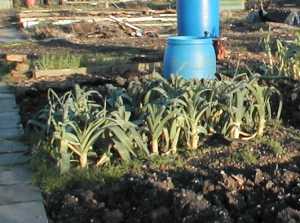
Leeks standing on the allotment in January,
There’s nothing to sow or plant outside, with the possible exception of garlic and even shallots if the weather is mild, but there are a few things like tomatoes and aubergines that can be started off under glass.
They will do best in a heated propagator but a south facing window sill will probably be good enough.
The big problem at this time of year is the lack of available light. Covering cardboard with aluminium foil and standing it to the north side of seed trays will reflect extra light and to help prevent leggy, drawn seedlings without the expense of special horticultural lights.
Another option is to use grow-lights. They used to use a lot of energy just to gain a little time but the new LED lights are much more energy efficient.
Onions from seed can be sown in January but unlike tomatoes, which like it hot, the ideal temperature for onions should be around or slightly below 15C. Watch out on sunny days, it may be cold outside but the temperature can shoot up in a greenhouse or coldframe.
Order seed potatoes/Grow potatoes under glass
Get your order in for seed potatoes and start chitting them! Delay might mean that you can’t get the varieties you want.
If you have a greenhouse and it’s not too cold outside, you could try growing 2 or 3 seed tubers in a bag of compost in there.
General Garden Tasks
In an ideal world, you’ll have the plot dug over, limed or manured and lots of lovely leafmould slowly forming in a cage. In the real world, make the most of any days when the weather is decent to catch up!
And if the weather isn’t kind concentrate on studying seed catalogues and placing your order in good time for when it does start to improve.
Fruit
Resist the temptation to try out new secateurs on stone fruits like cherry and damson, which should be summer pruned, although you can still prune apples, pears and fruit bushes as they’re dormant.
Bare rooted trees and bushes can still be planted until March.
Harvest
Parsnips and swedes still in the ground can come up when you are ready. Those left in should be covered with fleece or straw to stop them freezing solid into the ground.
If you have them Kale, Brussels sprouts and winter cabbage should last through to March. Celeriac and even celery should kept under a thick mulch.
Fruit & Vegetable Growing Guide for December
Predicting winter weather is as hard as predicting summer weather in Britain, which makes it difficult to advise on jobs. We’re pretty sure to see some hard frosts but those dreaming of a white Christmas are more likely to see a white Easter.
Planning the Year Ahead
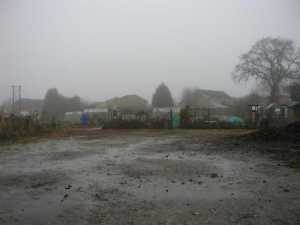
The allotment site in December, deserted, cold and damp.
It might be miserable outside but having to sit by the fire with your feet up is an opportunity to plan what you’re going to grow next year. December and January are the traditional months for placing seed orders.
Sit down with seed catalogues, get out your gardening books and start planning your campaign for the year ahead.
You may have favourite varieties, but don’t be afraid to try new ones, compare their performance – and perhaps find new favourites!
Sowing & Planting in the Vegetable Plot
There’s not a lot you can plant out in December but if you’ve not got round to it, you can plant out garlic direct. They actually benefit from a period of cold, which prompts growth later.
Onions sown towards the end of the month will make excellent plants and bulbs, benefiting from the longer growing period. Sow them in seed boxes under cover or in the greenhouse if you have one. You can use cold frames if they can be kept frost free. Usually that involves keeping an eye on the weather forecast and insulating the frame with anything from newspapers to old carpet when temperatures fall. Remember too that cold frames can heat up to high levels in a little winter sun so particular attention must be given to ventilation.
It’s worth removing any yellowing leaves from your winter brassicas. Dead leaves are doing no good and encourage diseases such as botrytis. Wildlife will be on the lookout for food, especially pigeons, so keep vulnerable plants like brassicas netted.
General Garden Tasks
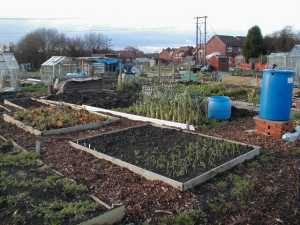
Allotment Plot in December, Leeks in the Background but not much else happening
It’s a good time for repairing and renovating. There’s always something to do if you look hard enough! Don’t forget you’re not going to have time when the season is in full swing.
Perhaps turn the compost heap over and ensure compost bins are covered to prevent excess rain leaching the nutrients and to keep in some of the heat of decomposition.
Keep your plot fairly tidy to avoid providing winter homes for pests, but don’t be afraid of a little untidiness to provide shelter for predators .
Fruit
Take hardwood cuttings from soft fruit. Gooseberries, red, white and black currants, worcesterberries, jostaberries and vines can all be propagated by inserting cuttings into the open ground. Choose sturdy well ripened shoots of this year’s growth cutting them just below a bud and trimming to just above a bud.
For black currants take cuttings about 8-10 inches (200-250 mm) long, 12-15 inches (300-380 mm) for the other fruits. Insert them into the soil to about half their length. It is customary to grow all except blackcurrants on a short stem – so remove the buds from the lower part of the cutting. All the buds should be left on blackcurrant cuttings.
It’s a good time to split rhubarb, dig up the old crowns and split from the top down with a spade into three or four. Leave on the surface so they get frosted before planting out in early Spring,
Check any ties and staking are secure for young trees or windrock can check growth or even kill the tree. You can plant bare rooted fruit trees and bushes in December and prune apple and pear trees.
Cut down canes of autumn-fruiting raspberries which have finished fruiting and burn to prevent fungal diseases spreading.
Harvest
There’s a surprising number of crops that can be available to harvest in December including winter brassicas such as Kale, cabbage and cauliflowers.
If you have Brussels sprouts start picking them from the base upwards, leaving the smaller ones at the top to develop.
Leeks should now be ready, just take what you need and leave the rest to stand until required.
Any remaining carrots should come out for storage in damp sand or peat in the shed. Parsnips and swedes can be lifted and stored the same way although they are very hardy and may be left if the ground is not needed. You can always cover them with fleece or straw to help stop the ground freezing them in.
Double check any vegetables in store and remove any that show signs of rot.
Fruit & Vegetable Growing Guide for November
November is the month when hard frosts and heavy rain usually arrive so it’s important to do whatever you can on your plot in case you don’t get another chance until spring.
Sowing & Planting on the Vegetable Plot
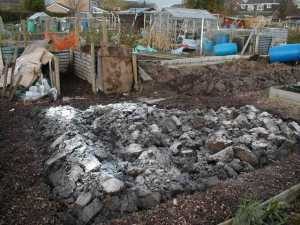
An allotment in November, soil turned over and lime applied
Now is the time to plant out garlic which likes a period of dormancy before it starts growing in spring.
Our heavy soil holds water and this creates a risk that cloves might rot before growth commences. To prevent this happening improve drainage by dropping an inch or so of sharp sand or grit into the base of the hole. Filling the hole above the clove with compost will also help to get them off to a good start.
Autumn planted broad beans go in now but, again, be aware that in heavy, wet soils the success rate will be lower than in lighter soil.
Hardy peas like Meteor can also be sown now.
General Garden Tasks for November
As ground becomes vacant continue digging it over and spread manure on the surface for worms to draw down. Leave the soil roughly dug in large clumps and the freezing and thawing of water in the soil will help to break it up finely so making easier to handle in the spring.
Digging over heavy soils like like ours is very beneficial. By loosening the soil and introducing air pockets it is prevented from turning into an impenetrable solid pan. Digging also exposes insect pests to the open air where birds can eat them. Double or deep digging and placing manure or compost in the base of trenches will deepen and enrich top soil.
It’s also a good time to add lime to soil but don’t add lime and manure at the same time. As well as counteracting acidification lime breaks down clay soil through a chemical process known as flocculation.
Keep a close eye on winter brassicas and cover with netting to protect them from birds.
Check that Brussel Sprouts are firmly rooted or windrock will break the root hairs and this will cause the sprouts to blow.
If you’re making a runner bean trench keep on filling it, adding a little soil over each layer of kitchen waste as you go.
If you’ve a good supply of leaves make leafmould. Start by building a leaf mould cage. This is very simple to do, just drive four stakes into the ground and staple chicken netting around to make a cage. then, pile in the leaves and leave them alone for a year. You will find the pile reduces by two thirds at least, so keep filling the bin as more leaves fall. If you have a garden vacuum mulcher that suck up leaves and chops them, you will find the leaves rot down much more quickly.
Fruit
It’s pruning time for apples and pears and they’ll benefit from some compost around the base as a mulch. Winter winds can shake the roots loose on young trees causing poor growth or even death so check that the ties and stakes are firm.
It’s also time to prune raspberries, blackberries and hybrid berries. Bare rooted canes can be planted outed out in November. Don’t forget to add plenty of compost to the soil and 250gr (8oz) per square yard of bonemeal.
Leeks should be coming ready now. Harvest every other one in a row leaving the rest to grow on. Brussels sprouts should be starting as well. Pick from the bottom of the plant upwards.
Also harvest kale and take up winter cabbages and cauliflowers. A cauliflower tightly wrapped in cling-film can be kept fresh in the fridge for as long as six weeks.
Maincrop carrots can be lifted to store safe from pests in damp sand. Parsnips can also be taken up but they do hold in the ground better than carrots.
Check any vegetables you have in store and removing anything that has started to rot before it spreads. Potatoes really need to be checked weekly and watch out for slugs that have emerged from a potato to damage others.
Fruit & Vegetable Growing Guide for October
October is the last of the hectic months on the vegetable plot. There’s little to sow and plant but still a fair amount to harvest and store for winter. The first frosts will kill all but hardy plants.
Sowing & Planting
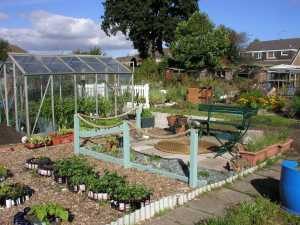
An allotment in October sunshine
Over-wintering broad beans can go in from the middle of the month to provide an early crop next year. They’re very hardy but don’t like sitting in water so on heavy soils like at Grange Lane they can be a gamble and it might be safer to just sow early next year.
The last sowing of beet leaf spinach can be made early in the month and you may be able to just fit in some Chinese cabbage.
October is the last chance for planting out Japanese onion sets. These are hardy, short-daylight onions so will be ready about a month earlier next year than other onions. It’s worth protecting them with a cloche or netting until well established so that pigeons don’t pull them from the ground. They don’t store well so don’t plant too many.
Planting out garlic can wait until November but there’s no harm in getting it done in October before the weather turns nasty.
General Garden Tasks
There’s not a lot to do except for keeping weeds in check. If you’ve got Brussels Sprouts it’s worth checking they’re firm in the ground as wind-rock breaks the tiny hairs on the roots that take in the nutrients. Earthing up a few inches around the stems and treading in or staking should be enough. In very windy areas put up a wind break. If the leaves are looking a little yellow, apply a high nitrogen liquid feed around each plant and this should perk them up enough to ensure good firm sprouts for Christmas.
Remove yellowed leaves from other brassicas. They are of no use to the plant and will encourage botrytis to develop.
Green manure crops like mustard should be dug in now. Generally Mustard produces a lot of foliage which can be cut with shears about a foot (30cm) off the ground. Compost the cut foliage and dig in the rest.
Dig over ground as it becomes vacant. Leave clods intact and the freezing / thawing action of winter weather will break them up, giving you a fine tilth to work with in the spring. Spread manure or compost over the surface and leave the worms to work it into the soil. If adding lime do not spread manure at the same time.
October and November are good months for serious digging. The deeper the dig, the more fertile the soil and the better the crop. To double dig, remove a trench and break up the sub-soil with a fork. Then add a good layer of manure or compost and place the soil from the next trench on top. This will greatly improve your soil.
Now is the time to concentrate on compost making. The last of the bulk foliage should be available to build a proper heap rather than a waste pile. Empty one bin into another, layer with lime and nitrogen rich manure as it builds. This will ensure decomposition gets off to a good start.
Consider where you intend to plant next year’s runner beans and start a bean trench, digging it out and lining with newspapers (six sheets thick) before adding compostable kitchen waste, lawn clippings etc and covering with soil.
Fruit
This is a good month to prune blackcurrants, redcurrants and gooseberries. Raspberries and blackberries need cutting back and tying in. These early winter months are ideal for planting out new stock. Make sure the ground is well prepared and add a good 500gr of bonemeal per plant to the base of the planting hole, forked in. This will slowly release nitrogen over the next year or two to give stronger plants sooner.
Harvest
Any remaining maincrop potatoes should come out. When the haulm (leaves) starts dying back, cut it off and leave the potatoes for a couple of weeks. This will make the skins set and prevent any potato blight spores from the haulm infecting the tubers. Wait for a sunny, dry day to dig up the potatoes, brush off excess soil and let them dry before storing in hessian or paper sacks in a frost free, dark shed.
The last of the beans should be picked now, compost the foliage but leaving the roots with their nitrogen full nodules in the soil will act as a fertiliser.
Maincrop carrots should be dug up to be stored in sand or peat but leave parsnips in the ground as they’ll be sweeter after a frost.
Drumhead cabbages that are ready should be harvested. They keep remarkably well in a frost-free shed but be aware that a slug that may be lurking under the leaves!
Any green tomatoes on outdoor plants should be picked before the frost gets them. Green tomatoes store quite well in cool conditions and slowly ripen or hasten the ripening process by leaving them in a tray with a ripe banana on a sunny windowsill. Otherwise make green tomato chutney.

